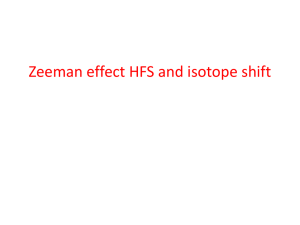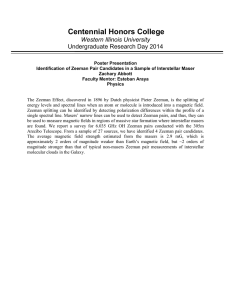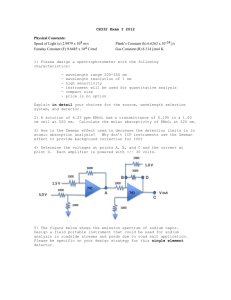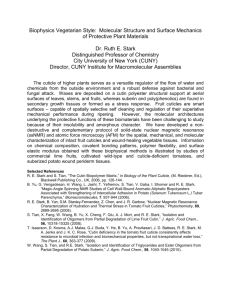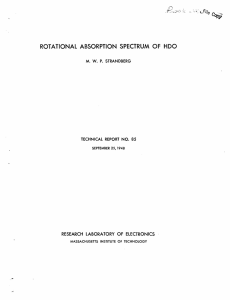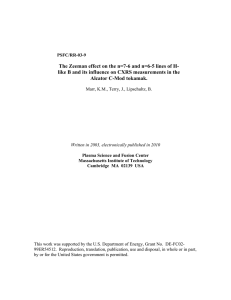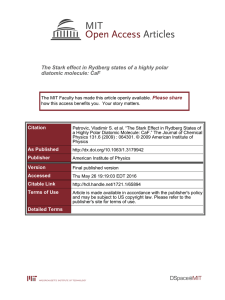Microsoft PowerPoint 2007
advertisement
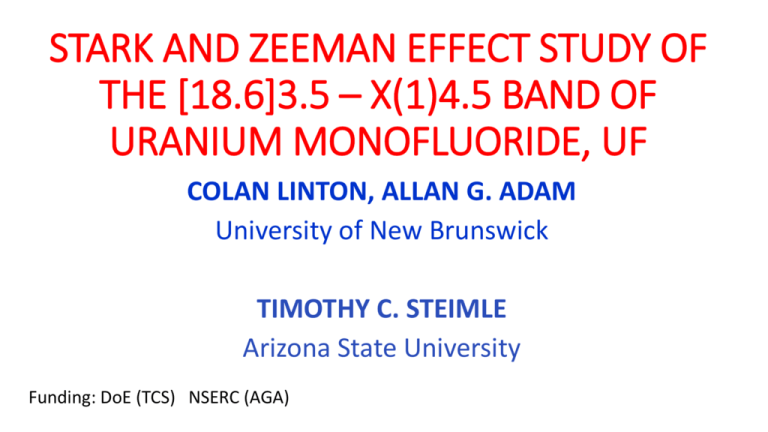
STARK AND ZEEMAN EFFECT STUDY OF
THE [18.6]3.5 – X(1)4.5 BAND OF
URANIUM MONOFLUORIDE, UF
COLAN LINTON, ALLAN G. ADAM
University of New Brunswick
TIMOTHY C. STEIMLE
Arizona State University
Funding: DoE (TCS) NSERC (AGA)
Previous work by Antonov and Heaven {JPC A117, 9684 (2013)}
Experiment:
Analysis of pulsed laser excitation spectrum of [18.6]3.5-X(1)4.5 transition of UF
Ground Ω = 4.5 state is derived from U+(5f37s2 4I4.5) F- configuration
Theory:
Calculations of excited state term energies in good agreement with experiment
Calculated dipole moment of ground state μel = 1.99 Debye
Calculated composition of ground Ω=4.5 state in terms of ΛS case (a) states
Present Work
• High resolution (FWHM ≤ 40 MHz) experiments at ASU
• 50 fold improvement in resolution over previous experiments
• Rotational analysis of [18.6]3.5 – X(1)4.5 0 - 0 band
• Stark effect to determine dipole moments
• Zeeman effect to determine configurational composition of electronic
states
• Use above to test theoretical predictions
Q branch of the [18.6]3.5 – X(1)4.5 transition of UF
Two extra lines for J′ ≥ 7.5: Upper state is perturbed
P(J′+1)
Q(J′)
R(J′-1)
J′=8.5
J′=7.5
J′=9.5
Stark Spectra of the P(4.5) Line of the [18.6]3.5 – X(1)4.5 transition of UF
3.43 kV/cm perpendicular
3.43 kV/cm parallel
Field free
Analysis of Stark effect data
Stark shift Stark
el EM J
(0.5034 MHz / D)
J ( J 1)
Fit Q(4.5) and P(4.5) Stark spectra at E = 3.43, 3.14, 2.86 and 2.57 kV/cm
with laser polarized parallel and perpendicular to electric field gave
μel(X(1)4.5) = 2.01(1)D μel([18.6]3.5) = 1.88(1) D
Obs. and calc. ground state dipole moments in excellent agreement.
Reduced dipole moments μel/Re = 0.99 and 0.92 D/Å
Equivalent to nuclear charges of ~0.20e and 0.19e
Observed and Calculated Spectra of P(4.5) Line:
E = 3.43 kV/cm perpendicular
Zeeman Spectra of Q(4.5 + 5.5) Transitions
Field
Calc
1.65 kG
parallel
Obs
0 kG
Analysis of Zeeman effect data
Zeeman shift is given by Zee
1.399 g e BM J
J ( J 1)
From fit to Zeeman data in R(4.5), Q(4.5), Q(5.5) at B = 1.65 kG
with laser polarized parallel and perpendicular to magnetic field
ge(X(1)4.5) = 3.28, ge([18.6]3.5)=3.26
Interpretation of ground state g-factor (3.28)
1. In terms of molecular 2S+1ΛΣ States
Antonov and Heaven calculated composition of ground Ω=4.5 state
80.74% 4Ι4.5 + 16.50% 4Η4.5 + 2.54% 4Γ4.5+ 0.22% 4Φ4.5
(Λ=6, Σ=-1.5)
(Λ=5, Σ=-0.5)
(Λ=4, Σ=+0.5) (Λ=3, Σ=+1.5)
For Hund’s case (a) states, ge = (Λ + 2.002Σ) giving a calculated g-factor
ge = 0.8074 x 3 + 0.1650 x 4 + 0.0254 x 5 + 0.0022 x 6 = 3.22
Calculation in very good agreement with experiment
2. In terms of parent atomic states 2S+1LJa
For a Hund’s case (c) molecular Ω state derived from atomic 2S+1LJa state
J a ( J a 1) S ( S 1) L( L 1)
g e 1
2 J a ( J a 1)
Ground Ω=4.5 state of UF is derived from U+ 4I4.5 state
L = 6, S= 1.5, Ja = 4.5, Ω = 4.5
ge (calc) = 3.27
ge (exp) = 3.28
Molecular ground state derived entirely from U+ (f3s2) 4I4.5 state
Excited [18.6]3.5 State (ge = 3.26):
Transition is Ω = 3.5 – 4.5.
Logical choice for ΔΩ = -1 transition to predominantly 4Ι4.5 state is 4Η3.5
For 4Η3.5 ge = 5 + 2.002 x -1.5 = 2
Other possibilities giving an Ω = 3.5 state
4Γ
4Φ
4Δ
(g
=
3):
(g
=
4):
3.5
e
3.5
e
3.5 (ge = 5)
Excited Ω = 3.5 state is possibly a mixture of predominantly 4Γ3.5 and 4Φ3.5
with possibly small contributiions from 4Η3.5, 4Δ3.5 and other states
Molecular parameters for the X(1)4.5 and [18.6]3.5 v = 0 states of UF
State
Parameter
X(1)4.5
[18.6]3.5
T0 (cm-1)
0
18624.5349(15)a
B0 (cm-1)
0.23247(3)
0.22754(3)a
μel (Debye)
2.01(1)
1.88(1)
ge
3.28(1)
3.26(1)
a
From fit to lowest 4 levels
Conclusions
1. Field free spectra show perturbations in the upper state [18.6]3.5
2. Stark effect shows ground state dipole moment of 2.01D in excellent
agreement with Antonov and Heaven calculation. Nuclear charge ~0.2e
3. Zeeman effect shows that
(i) the calculated compostion of the X(1)4.5 ground
state in terms of Hund’s case (a) ΛS states reproduces the observed
electronic g-factor very well.
(ii) The ground state arises almost entirely from the U+(5f76s2 4I4.5) Fconfiguration
4. The discussion on the upper state configuration is highly speculative.
The g-factor suggests possible configurations and eliminates others .
5. More theoretical calculations are needed

